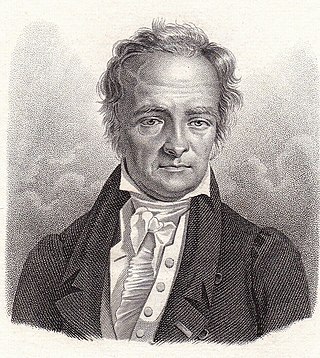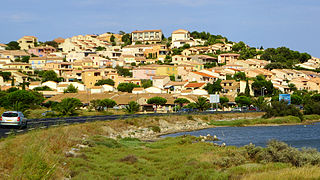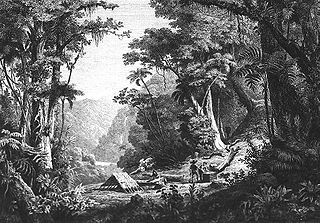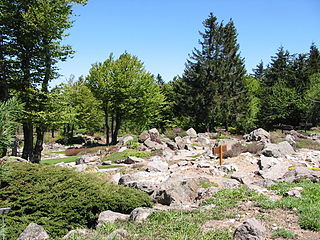Related Research Articles

Louis Augustin Guillaume Bosc was a French botanist, invertebrate zoologist, and entomologist.

Leucate is a commune in the Aude department in southern France. It lies between the Mediterranean Sea and the lagoon Étang de Leucate.

Hugh Algernon Weddell was a physician and botanist, specialising in South American flora.
Charles Henri Marie Flahault was a French botanist, among the early pioneers of phytogeography, phytosociology, and forest ecology. The word relevé for a plant community sample is his invention.

Auguste Jean Baptiste Chevalier was a French botanist, taxonomist, and explorer of tropical Africa, especially of French colonial empire in Africa that included Côte d'Ivoire. He also explored and collected plants in South America and tropical Asia. Chevalier was a prolific contributor to the knowledge of African plants, studying forest trees and their woods, grasses, and agricultural plants of the continent. Unlike other botanists who studied the plants of tropical Africa, Chevalier also ranged to the floral regions of the Sahara.
Aimée Antoinette Camus was a French botanist. She was best known for her study of orchids and oaks. Camus also has the legacy of authoring the second highest number of land plant species among female scientists, in total naming 677 species.

Étienne Pierre Ventenat was a French botanist born in Limoges. He was the brother of naturalist Louis Ventenat (1765–1794).

Antoine Laurent Apollinaire Fée was a French botanist who was born in Ardentes, 7 November 1789, and died in Paris on 21 May 1874. He was the author of works on botany and mycology, practical and historical pharmacology, Darwinism, and his experiences in several regions of Europe.

The Jardin d'altitude du Haut Chitelet is a botanical garden specializing in high-elevation alpine plants, located at about 1220 metres elevation on the Route des Crêtes, near the peak of Hohneck (Vosges), about 1 km south of the Col de la Schlucht in Vosges, Lorraine, France. It is maintained by the Jardin botanique du Montet and the Conservatoire et Jardins Botaniques de Nancy, open daily in the warmer months; an admission fee is charged.
Zangasso is a small town and commune in the Cercle of Koutiala in the Sikasso Region of southern Mali. The commune covers an area of 452 square kilometers and includes 10 settlements. In the 2009 census it had a population of 19,925. The small town of Zangasso, the administrative centre (chef-lieu) of the commune, is 30 km southwest of Koutiala on the Route Nationale 11 that links Koutiala with Sikasso.
Alfred Wesmael was a Belgian professor of botany. His outstanding work in taxonomy saw him invited to become Visiting Professor at the University of Washington.
Paul Évariste Parmentier was a French agronomist and botanist.

Charles Henry Philippe Lévêque de Vilmorin was a French botanist, the son of Pierre François "Louis" Lévêque de Vilmorin (1816-1860) and Elisa Bailly (1826-1868), and grandfather of the novelist, poet and journalist, Louise de Vilmorin. Seven generations of the family of Vilmorin contributed greatly to French agriculture for over two hundred and thirty years by their improvements of sugar-beet and wheat - they published more than three hundred and sixty articles on plants in agriculture, horticulture, floriculture and botany.

Jean-Baptiste François Rozier was a French botanist and agronomist.

Napoléon Doumet-Adanson (22 October 1834, Guéret – 31 May 1897 Château de Balaine was a French naturalist. He was a botanist specialising in the flora of Tunisia. He was a founder member of the Société d'horticulture et de botanique de l'Hérault. Doumet was also interested in entomology. He was a Member of the Institut de France.

Édouard-Pierre-Marguerite Timbal-Lagrave was a French pharmacist and botanist. He specialized in the flora of southwestern France, including the Pyrénées and Corbières Massif.
Georges Kuhnholtz-Lordat was a French agronomist and phytogeographer.
Ulmus glabra 'Pyrenaica' is a local cultivar of the Wych Elm, described as Ulmus pyrenaica, the Pyrenees Elm, by de Lapeyrouse in Supplément à l'Histoire abrégée des plantes des Pyrénées (1818), from trees in the Port [:pass] de la Picade in the Basses-Pyrenees. Chevalier added a further description in 'Les Ormes de France' (1942), and a second provenance in the nearby Bagnères-de-Luchon area. Herbarium specimens are held in the Muséum national d'histoire naturelle in Paris, where U. campestris var. montana latifolia is given as a synonym.

Henri Stehlé was a French agronomist, botanist and ecologist specialized in tropical agriculture. In 1949 he founded the Agronomic Research Center of INRA Antilles-Guyane in Guadeloupe, of which he was Director until 1964. As botanist he worked mainly in Guadeloupe and Martinique in collaboration with his wife, Madeleine Stehlé, and Reverend Father Louis Quentin. Stehlé focused his work on two plant families: Orchidaceae and Piperaceae. The abbreviation Stehlé is used to indicate Henry Stehlé as the authority for many plant names.
References
- ↑ Bulletin de l’Association amicale des anciens élèves de l'École normale supérieure, 1986, p. 75-77
- ↑ "Les agrégés de l'enseignement secondaire. Répertoire 1809-1960 | Ressources numériques en histoire de l'éducation". rhe.ish-lyon.cnrs.fr. Retrieved 15 May 2021.
- ↑ La Station Internationale de Géobotanique Méditerranéenne et Alpine, in the Revue de botanique appliquée et d'agriculture coloniale, 1930, vol.10, No. 107, p. 553-557
- ↑ "La Station Internationale de Géobotanique Méditerranéenne et Alpine". Journal d'agriculture traditionnelle et de botanique appliquée. 1930. pp. 553–557. doi:10.3406/jatba.1930.4876 . Retrieved 12 February 2024.
- 1 2 Sophie Bobbé, Il était une fois un parc... : Histoire de la création du parc national des Pyrénées, dans Histoire des parcs nationaux, Éditions Quae, 2009 ISBN 9782759201822
- ↑ Drut, Olivier. "CTHS - CHOUARD Pierre". cths.fr (in French). Retrieved 16 May 2021.
- ↑ "Chouard, Pierre | International Plant Names Index". www.ipni.org. Retrieved 15 May 2021.